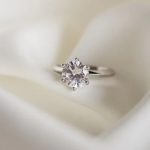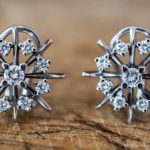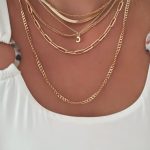When jewelry gets broken, it can be heartbreaking. Whether it is a family heirloom or an extravagant gift from a loved one, broken jewelry is cause for dismay. It doesn’t have to stay broken though. If the heartache of seeing a beloved piece of jewelry in disrepair has become too much, there are steps you can take to repair your cherished pieces.
Step 1 – Evaluating the Damage
In order to properly repair broken jewelry, it’s important to first evaluate the damage. An accurate assessment of the injuries sustained on your necklace, bracelet, earrings or ring will determine just how difficult the repair job may be.
It is also important to check that any gems are still firmly attached before attempting a repair. That way if it’s too difficult and requires special tools, you can decide which option would be more time-effective and cost-efficient – namely whether having it repaired at a professional store or attempting the job yourself at home with DIY methods.
Step 2 – Doing At Home Repairs
Fortunately, many types of repairs can be done without special equipment and without needing professional help. Minor repairs like straightening bent settings and replacing missing clasps and jump rings usually call for household tools such as pliers and cutters that you might already own in your toolbox or craft drawer at home.
If stones have fallen out of place due to wear-and-tear over time, using epoxy glue and rope thread is an easy solution that securely puts them back into positionwith an invisible seal. Additionally, liquid polish cleaner can make dull gold shine again by removing years worth of dirt buildup making sure that any scratch remains filling with polish substance – this should however remain the last resort method for polishing.
Types of Jewelry Repair
Jewelry repair is the art of restoring a piece of jewelry to its original condition. Some repairs may require professional assistance, while other projects can easily be done with supplies and tools that are widely available.
It’s important to determine the cause of damage to make an informed decision as to whether it should be repaired at home or if taking it to a professional jeweler is necessary. Understanding the different types of jewelry repair and how they are completed will make any project easier.
Cleaning and Polishing Repair: This type of repair entails simply cleaning the jewelry down to its original shine. Cleaning can remove dirt and tarnish which can really improve a piece’s appearance, making it look new again.
To complete this type of job, there are many products for sale which include specialized polishers and cleaners depending on the material such as gold, silver, and platinum or costume pieces like plastic or wood. Careful instruction should be followed during this process in order not to ruin the piece permanently.
Stone Replacement: This type of job requires replacing missing stones in fashion/costume pieces due to falling out, cracking, or chipping. Though there are some pieces like small metal studs that can easily be replaced by anyone with a steady hand, more intricate jobs could require skillful experience from a professional jeweler who specializes in stone replacement. This kind of repair involves carefully examining and measuring the setting where the stone sat before being removed before installing a repl.
Tools and Materials You Will Need
-Jeweler’s pliers
– Small saw
– Fine sandpaper
– Metal files
– Wire cutters
For many people, jewelry is more than an accessory. It’s a sentimental memento, often given to us by someone we love. Unfortunately, all jewelry is eventually going to break down.
Whether it’s due to everyday wear and tear or a single incident, jewelry will need to be repaired at some point. Making these repairs can be intimidating, but with the right tools and knowledge it won’t seem as daunting. Here are some tips for how to repair broken jewelry:
First, gather the appropriate tools and materials needed for repairing your broken jewelry item. Jeweler’s pliers are usually required for manipulating clasps and other small parts during repairs. You may also need a small saw or wire cutters in order to cut any excess metal from the piece that needs moved or removed in order complete the repair.
For sanding down jagged edges use fine sandpaper or metal files for a smoother finish. Additionally you may need super glue or specialty solder depending on what kind of repair job is being done-if necessary do research ahead of time into which one will better suited your project before beginning work on the broken jewelry item.
Second, carefully examine the item being repaired – taking note of specific features like strength and other important elements like stones set in place which must remain secure during the repair process. Once you have thoroughly looked over your item, begin repairs accordingly by following each step carefully so as not to make too big of mistake while making careful notations along they way should any adjustments need further corrections after first attempts at fixing have been assessed.
Lastly connect fastenings together (whether its beading wire, head pins etcetera) according special care given when using delicate components such as pearls or crystal rhinestones – ensuring all beads fit snugly into place without gaps between them so that piece looks properly finished.
Lastly, use applicable cleaner or polish if necessary on any oxidized areas caused during the repair process in order to avoid any further degradation of the original look and feel – for example using polishing cloths specifically designed for silver application can greatly enhance color vibrancy giving shine back where it was lost.
Then go over each individual part with microfiber cloth in case fingerprints have been left behind from hand oil during actual repairs themselves (this should help avoid tarnished residue that could arise prematurely).
Doing so can help keep pieces looking beautiful despite their imperfections as jewelers believe “perfection isn’t always possible” – allowing those cherished memories embodied in our beloved jewelry continue make an lasting impression whenever its seen.
Safety Considerations When Dealing with Broken Jewelry
When it comes to repairing broken jewelry, safety is paramount. It’s essential that all materials used in the process of repairing broken jewelry are handled and disposed of properly.
This includes any clasps or pins that have snapped off during the repair process, threaded jewelry pieces, sharp edges and any loose stones that may have come out of the piece. All pieces should be rinsed in cold water both before and after soldering to ensure no pieces are lost post-repair.
Safety equipment is also required when dealing with tools and materials used for making repairs. Goggles should be worn at all times when working with metals such as silver, copper or gold, which can heat up quickly when being worked on with a soldering iron.
Tools such as tweezers, pliers and small hammers should also only be used by those wearing protective gloves; this helps minimize the risk of cuts caused by sharp edges or sharp components within the broken jewelry items being repaired.
Lastly, avoid using harsh chemicals to clean your jewelry-jewelry detergent with a mild cleaning solution should be adequate for most cases. Solvents such as bleach, acetone or vinegar should never be used as they will damage the finish or coating on your jewelry piece at best, and possibly cause corrosion at worst.
Any work done on precious stones such as diamonds must always be handled by a professional jeweler whenever possible; this ensures that there is no additional damage incurred to the detail or quality of your delicate gemstone item.
Understanding the Kind of Repair Needed
When you have a piece of broken jewelry, the first thing you need to do is determine what kind of repair needs to be done. If a stone has fallen out, if something has snapped or cracked, or if you have a loose setting and the stone is nearly falling out, you will need to assess and decide how best to move forward with the repair.
This means that it could be as simple as purchasing a new clasp or finding and replacing a missing stone. However, it also may require more extensive evaluation.
Inspecting and Preparing
Once you know the nature of your repair, it’s important to inspect the piece more closely in order to uncover any additional damage that may be caused by the broken area. To start with, most pieces can be cleaned with an ultrasonic machine that uses sound waves to remove debris from delicate surfaces.
Additionally, it’s best to check for any other damage around the repair sight before attempting any fix. Not doing so can lead to further injury or breakage while trying to make repairs or assemble your jewelry again after fixing it, so this step should not be overlooked.
Finding Replacement Parts
Depending on what type of damage is present in your jewelry, you may need replacement parts such as clasps or stones in order complete your repairs. The easiest option here is often to visit your local jeweler and see what they have in stock since they are likely familiar with components of many different jewelry types based on their experience in repairs and restoration.
But if they don’t hay have exactly what you’re looking for, another great place to look is online which gives far more possibilities and availability than juggling through shelves at multiple stores on foot would ever allow for. Most websites will also list detailed information about each item and even show them up close so that you are sure that what arrives matches up with what exactly was ordered when replacing materials for your project.
How to Identify Broken or Damaged Clasps
Jewelry clasps are a great way to secure necklaces, bracelets, and other jewelry pieces. However, they can often become faulty due to wear and tear or a manufacturing defect. It is important to be able to identify when a clasp is damaged so that you can replace it or repair it before it gets worse.
The first way to tell if your clasp is faulty is to physically inspect the item of jewelry and look for any signs of damage, such as bent wires or weak points that could break under pressure. Clasps also tend to wear away over time so any discoloration or scuff marks in the metal should also be taken into consideration. Another method of identifying whether your clasp has been compromised is by testing its closure capabilities.
To do this simply unscrew the lobster claw on the bracelet or necklace and then press down on the shepherd’s hook which should physically move slightly further open but return back closed when released. If you find that this does not occur then it may indicate that the clasp needs replacing or requires some adjustment in order to function correctly.
Once you have identified any potential faults with your clasp it is essential that you carry out repairs as soon as possible in order to prevent any further damage being caused by movement within the clasp mechanism itself.
A great way of restoring functionality back into clasps is by lubricating them with an oil-based lubricant such as WD-40 This will help stop any rusting of metal components whilst simultaneously ensuring smoother operation when closing and opening your jewelry item – all done without having to directly touch the inner workings thus helping preserve its appearance over time.
Additionally, if major repairs are needed such as bending wires back into alignment then seeking assistance from a professional jeweler will ensure a more secure fixing and therefore safe long term operation too.
How to Remove Broken Clasps or Links
If your jewelry has lost a clasp or link, it may seem like it’s beyond repair. But all is not lost – with right supplies and some patience, you can fix your broken jewelry. Preparing to repair broken jewelry begins by gathering the necessary tools and supplies.
You’ll need needle-nose pliers, jump rings, wire cutters, heavy-duty scissors and adhesives such as epoxy. A paste made from baking soda also can be used to help prepare the surface for adhesion.
Once you have gathered everything you need, begin by removing any of the remaining pieces that are still intact. Next, clean any visible dirt or debris off of the broken area using a toothbrush and warm soapy water. Focus on any metals that need attention to prepare them for mending.
After all traces of dirt are gone, use a polishing cloth to buff out any discolored areas or scratches. Repairing damaged metal requires precision and attention to detail – observe closely so you don’t miss anything.
Now that the jewelry is ready for repair, begin by making sure there are no rough or frayed edges around the breakage. Use your needle-nose pliers and a fine file to gently sand down these edges until they’re smooth and even with the rest of the metal surfaces. Then you can use either jump rings or epoxy glue (depending on type of materials) to secure pieces back together again.
Jump rings require looping through both ends of the broken piece with small gaps between each one – make sure these gaps are kept uniform throughout for an even hold that won’t appear obvious when worn. For epoxy glues, carefully spread on an even coat with a wooden toothpick around both sides being careful not to allow too much seepage onto other portions of jewelry itself as this could damage other parts over time if left uncleaned.
Finally let both drying methods (jump rings or glue) follow their instructions before wearing the repaired item again so that it can properly heal over time without breaking apart again in future wearings or cleaning sessions.
Repairing Broken or Damaged Prongs
When it comes to fixing broken jewelry, prong repair is often necessary. Prongs are the small metal pieces that hold a stone in place on a ring or necklace. If you have ever dropped your endearing jewelry and noticed one of the prongs bent out of place, it will require some skillful mending to correct the damage. With new tools and technology, the process is easier and very straightforward.
The first step in repairing broken prongs is to assess the damage done to your piece. This can include cracks, bends, and complete breakage of one or more of the prongs around the jewelry. A good magnifying loupe will allow you to inspect any damage beneath the stone for an accurate assessment. With a known set of facts about what needs repairing, it’s then time to take action.
Repairing can either be done with a machine or by hand depending on what type of equipment you have available along with your skill level. Mass market machines are becoming increasingly affordable and easy to use which make them great tools for simple repairs like putting prongs back into position without needing years or experience in jewelry repair.
For more detailed crafting such as replacing entire pieces of prong material, skilled work by hand is really required as you’ll need exceptionally fine motor skills along with special tools specific for high-grade repairs such as setting burs and polishing sticks.
Once an area has been professional struck down or soldered correctly onto your piece, there should be little worry about future problems since most damages are caused by force from drops and contact with other hard surfaces throughout regular wear rather than material defects mechanically leading to broken pieces within itself when intact.
The most important thing left to do at this point is giving any newly repaired section a final polish up in order to restore its full shine and make sure no rough edges remain around where old parts once were attached.
Reinforcing and Stabilizing Jewelry
When a piece of jewelry is broken, it can be fixed with a little bit of effort. There are different repair techniques depending on the item and the extent of the damage; for instance, if a stone is cracked or missing from a ring, it can be replaced.
However, some jewelry repairs require more skill and expertise than others. For example, if two parts have been separated and need to be reattached, you should seek out a professional jewelry repair service to ensure that the pieces stay secure and create an overall good looking piece of jewelry.
Before beginning any repairs, it is important to reinforce and stabilize the items that make up any piece of jewelry. This consists of cleaning any metal elements and smoothing out indentations or abrasions where necessary. If there are miscellaneous parts such as clasps, rings or pins involved in the repair process they must also be secure by tightening screws or replacing lost components prior to attempting any further repairs.
If you are working with a strand of beads which has become broken due to wear or string breakage then new thread should be inserted through holes or crimp tubes for effective reconstruction. A specialized tool called pliers may also be needed for securing any secured ends such as knots or barrel clasps if part of your design includes those elements.
This ensures that the strand does not come undone after its been put back together in order for your design to remain complete throughout wear time. Any beads damaged from hard wear should also be addressed in this step sorting through replacements or utilizing special bead glue for interior cracking where possible before strung on thread to securely attach them in their intended place on the completed design.
Making sure all components are tightened/secured following proper stabilization protocols provides additional support reducing chances of further damage during wear time prolonging overall life span forecasted when properly maintained over various cycles interesting pattern used here tying all info together smoothly for great motivation topic. Now that all components have been reinforced structural integrity can now constructed/added without fear of breaking/melting apart in near future with proper care given.
Cleaning and Polishing Jewelry After Repair
Repairing broken jewelry can be a tricky process. Depending on the type of jewelry, such as delicate vintage pieces or more robust pieces made with modern technology, you may need to go to a professional jeweler. Before attempting any repairs yourself, it is important to check that there are no contaminants inside of the metal before repair. Contaminants such as dirt, dust and even metal filings can weaken the metal used in many types of jewelry.
After the repair is complete, it is important to take special care when cleaning and polishing your newly repaired jewelry. To prevent damage to the repair itself, it’s best to avoid harsh chemicals or abrasive clothes for polishing.
It is recommended that you use a specialized cleaning liquid followed by a soft cloth for buffing away dust and oils from the surface of your jewelry.
To ensure that all elements that were used are securely in place during the repair process, run each piece through an ultrasonic cleaner at least twice after polishing has been completed This will also ensure that any components inside of difficult to reach areas have been safely taken into account for further inspection if necessary down the road.
Inspections should continue on a regular basis in order to keep your jewelry looking its best and lasting longer than usual. During these inspections check for loose stones and make sure any secure parts remain in their correct position over time with minimal wear and tear occuring.When inspecting fine details such as decorations like engraving make sure they have not faded or been degraded due to wear and tear over time.
This maintenance should keep your repairs in good condition for years to come so long as you do not attempt additional repairs without consulting a professional first.
Reassembly of the Jewelry Piece
Broken jewelry is not a total loss; with some patience and the right tools, it can be repaired. The first step in repairing broken jewelry is to assort the pieces. Lay out all of the chains, clasps, and pieces so that you have a better idea of how they belonged together.
Once the pieces are sorted and laid out together, it will be clear what part of the jewelry will need to be replaced or repaired. From there, it’s time to put the puzzle back together again.
Depending on the type of jewelry one wants to repair, soldering may need to be used in order to fix links in a chain or join together sections of metal. Soldering requires special tools like solder wire, flux, and a soldering iron which must all be obtained before attempting this method as these tools can create toxic fumes on their own so good ventilation must also be taken into consideration when performing this task safely.
Additionally, solder can cause harm if ingested or inhaled – protective clothing such as goggles, long socks, and protective gloves should always be worn when handling any type of soldering materials.
If re-soldering links or components isn’t an option for whatever reason then another route would be to simply use jump rings which comes in plated silver or gold depending on your desired finish.
Using jump rings typically includes attaching them with specialized flat nose pliers onto existing links or components from both sides at once creating a secure lasting closure that won’t easily break apart while wearing it again without having to resort to solder and other complex tools mentioned above.
Placement at alternating angles will achieve higher levels of security towards refastening the chain back together with confidence allowing its user to once again proudly display the jewelry piece intact.
Testing and Final Inspection of the Repaired Jewelry
When repairing broken jewelry, it is important to conduct a thorough testing and final inspection process to ensure the piece has been properly restored. The first step in this process is to visually inspect the repair once it is complete. If there are any noticeable flaws or deformations of the metal, then further adjustments can be made. It may also be necessary to use a magnifying glass for more intricate repairs such as those on stones or delicate filigree designs.
Once any needed repairs are complete, then a strength test should be administered to determine how well the piece stands up under pressure. You can use tools such as pliers or tweezers if available to see if any stress fractures occur or greater force is needed than anticipated for the repair.
Additionally, an endurance test could be carried out with light wear and tear simulated to make sure no further damage occurs over time. This should all be tried gently and then observed at regular intervals in order to maintain an accurate picture of the stateof the item in review.
The next step would be to carry out a materials test – this ensures that only materials suitable for the job were used during restoration such as solder being appropriate for gold pieces rather than something else like silver plating for example.
Once again here, you could use tools such as a loop set or even some corrosive liquid throat examine acidity levels of gold and precious metals more deeply; this is especially important when determining whether items have been fortified during their repair journey or not.
Lastly, an overall cleaning process should take place before finalizing any repairs; this will ensure that dirt buildup has been adequately removed from hard-to-reach places on your item which may affect its structural stability over time.
In conclusion, ensuring jewelry repairs are carried out properly involves a few steps – visual inspection of the finished product, strength/endurance testing, examination of materials used, and finally cleaning all components before setting aside your item as ‘fully repaired’. When done correctly – these processes can help restore previously damaged pieces back into their original condition (or better.) – always allowing them plenty more years’ worth of life again.
Tips for Maintaining Your Jewelry
Broken jewelry is often one of the biggest disappointments for an owner. Not only does it lose its value and use, but it also can erase any sentimental connection the owner may have had with the piece. Luckily, with some patience and skill, it is possible to repair broken jewelry yourself.
The first step in repairing broken jewelry is determining what part of the piece has been damaged. Is the metal bent out of shape? Has a stone fallen out?
Are there problems with worn clasps or links? Knowing exactly what needs to be fixed will help you decide on how to best go about the repair.
You will likely need specialty tools depending on your specific issue; however, some common materials that jewelers use include bobby pins, wooden toothpicks, skewers, laser-cut foam sheets for polishing stones and surfaces, polishing sponges and buffers for metals as well as tweezers and magnification glasses to get an up close look at intricate details.
Next, if possible try to determine what type of corrosion or damage has occurred on the piece. Common types of corrosion found on jewelry include oxidation due to air exposure and green corrosion from contact with chlorine or alcohol-based solutions such as hairspray or perfume.
These two types are easily fixable; both require a little polishing with a soft cloth buffing wheel and stream buffer containing jewelery rouge polish or professional grade metal cleaner. For more complex types of damage such as bent metals over time by wear and tear can be difficult to mend without specialized tools – best left to a professional jeweler specializing in repairs.
Finally, once you have determined what needs repairing and think you know how to go about it – now comes the work itself. If replacing stones or beads then make sure they fit properly into their setting before trying glue them in place using slow dry glue formulated specifically for metal restoration (avoid cyanoacrylic glues).
If bending metal back into place use something like pliers that will not leave marks (specialty hinged beading/pliers are great for small pieces). Finally remember that every tiny detail counts when you’re restoring your precious jewelry so invest in quality tools like goldsmith olivettes used for shaping springs for necklaces & bracelets so each section correctly aligns again after manipulation.
When maintaining your repaired jewelry make sure diamond/gemstone settings hold tight by checking once every month or two. Pay special attention to prongs particularly after being exposed to chlorine pools or harsh abrasives while cleaning them (avoid ultrasonic cleanings). A yearly visit to an experienced professional jeweler ensures all parts of your cherished piece will continue looking beautiful despite everyday wear & tear incurred from regular activities – giving you peace of mind & your treasured possession many extra years of shine.

Welcome to my jewelry blog! My name is Sarah and I am the owner of this blog.
I love making jewelry and sharing my creations with others.
So whether you’re someone who loves wearing jewelry yourself or simply enjoys learning about it, be sure to check out my blog for insightful posts on everything related to this exciting topic!





